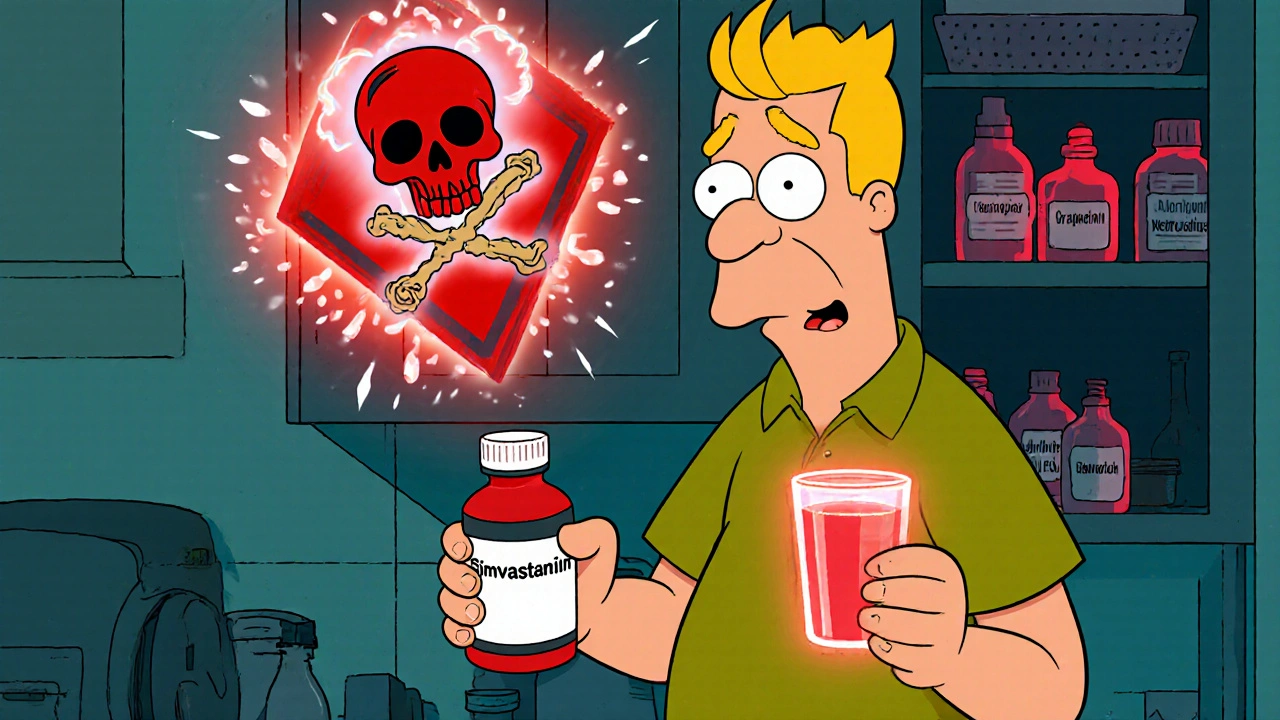
Simvastatin is one of the most commonly prescribed cholesterol-lowering drugs in the U.S., especially in its generic form. But for many people taking it, there’s a hidden danger lurking in their medicine cabinet - not from the statin itself, but from what else they’re taking alongside it. The risk isn’t theoretical. It’s real, deadly, and preventable. Simvastatin can turn from a lifesaver into a silent threat when mixed with certain medications, supplements, or even common foods like grapefruit juice.
Why Simvastatin Is Different
Not all statins are the same. Simvastatin is broken down in your liver by an enzyme called CYP3A4. That’s fine - until something blocks that enzyme. When that happens, simvastatin builds up in your bloodstream. Higher levels mean higher risk. And the higher the dose, the worse it gets. The FDA flagged this in 2011 after reviewing thousands of adverse event reports. The 80 mg dose of simvastatin showed a 6.5 times higher risk of severe muscle damage compared to lower doses. In the SEARCH trial, patients on 80 mg had a 0.61% chance of developing rhabdomyolysis - a condition where muscle tissue breaks down, leaks into the blood, and can cause kidney failure or death. At 20-40 mg, that risk dropped to 0.08%. Today, doctors rarely start new patients on 80 mg simvastatin. In fact, new prescriptions for that dose have dropped by over 80% since 2011. But millions of people are still taking it - often because they were started on it years ago and never switched. And many don’t know the risks.The Deadliest Combinations
Some drugs don’t just interact with simvastatin - they turn it into a poison. These are the ones you need to avoid at all costs:- Antifungals: Ketoconazole, itraconazole, voriconazole, posaconazole - these are used for yeast and fungal infections. Even short courses can spike simvastatin levels.
- Antibiotics: Clarithromycin and erythromycin (not azithromycin) are especially dangerous. A patient on 40 mg simvastatin who takes clarithromycin for a sinus infection can develop muscle pain and weakness within 48 hours.
- HIV meds: Ritonavir, atazanavir, darunavir - all HIV protease inhibitors. These are among the strongest CYP3A4 blockers known.
- Immunosuppressants: Cyclosporine (used after transplants) and danazol (used for endometriosis) can increase simvastatin exposure by up to 10-fold.
- Heart meds: Amiodarone and amlodipine - both commonly prescribed for arrhythmias and high blood pressure. The FDA says if you must take them with simvastatin, never exceed 5 mg daily.
And here’s the kicker: many of these drugs are prescribed for short-term use - a 10-day course of antibiotics, a week of antifungals. But patients often keep taking simvastatin, unaware that the danger doesn’t go away when the other drug does. The muscle damage can start quietly, with vague fatigue or soreness, then spiral fast.
Grapefruit Juice Isn’t Just a Warning - It’s a Red Flag
You’ve probably heard not to drink grapefruit juice with statins. But most people don’t realize how powerful this interaction is. A single 8-ounce glass of grapefruit juice can increase simvastatin levels in your blood by up to 260%. That’s not a minor bump - that’s the equivalent of suddenly doubling or tripling your dose. A 2023 study found that 43% of patients on high-dose simvastatin continued drinking grapefruit juice despite being warned. Some thought it was just a myth. Others didn’t realize orange juice or pomelo had the same effect. Even small amounts matter. You can’t outdrink it. You can’t wait a few hours between juice and pills. The enzyme inhibition lasts for hours. If you’re on simvastatin, skip grapefruit, pomelo, Seville oranges, and any juice labeled “grapefruit blend.” No exceptions. No “just a little.”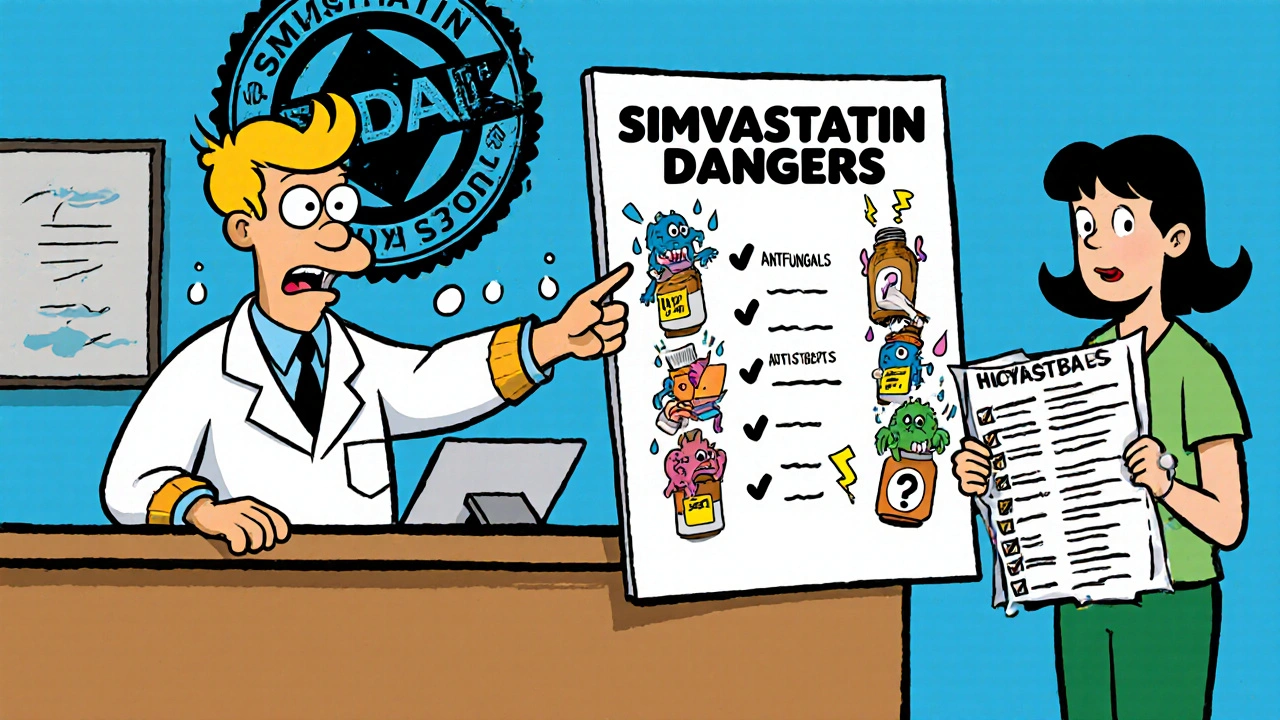
Other Risky Players: Colchicine, Niacin, Fibric Acids
Not all dangerous interactions are with CYP3A4 inhibitors. Some work differently but still raise the risk of muscle damage.- Colchicine: Used for gout and some inflammatory conditions. Even at low doses, combining it with simvastatin increases rhabdomyolysis risk. This combo is especially risky in older adults or those with kidney problems.
- Fenofibrate: Often prescribed with statins for very high triglycerides. While fenofibrate itself is safer than gemfibrozil, the combination still raises muscle injury risk.
- Niacin: Sometimes used to raise HDL (“good”) cholesterol. But it adds to muscle toxicity, especially at high doses (over 1,000 mg/day).
Doctors sometimes prescribe these combos for patients with stubborn lipid profiles. But the trade-off isn’t worth it for most. If you’re on simvastatin and your doctor adds one of these, ask: “Is there a safer alternative?”
What to Do If You’re Already Taking Simvastatin
If you’re on simvastatin - especially at 40 mg or 80 mg - here’s what you need to do right now:- Check every medication: Include prescriptions, over-the-counter drugs, and herbal supplements. Don’t forget antacids, cold meds, or sleep aids - some contain hidden CYP3A4 blockers.
- Ask your pharmacist: Pharmacists run interaction checks every time you fill a prescription. Ask them to review your full list. Many pharmacies now offer free med reviews.
- Test for genetic risk: The SLCO1B1 gene variant makes some people far more sensitive to simvastatin. If you’ve had unexplained muscle pain on statins before, ask your doctor about genetic testing. People with this variant have up to 4.5 times higher risk of muscle damage.
- Get liver and muscle tests: If you’re on simvastatin, get ALT/AST (liver enzymes) and CK (muscle enzyme) tests every 3-6 months. Don’t wait for symptoms.
- Know the warning signs: Unexplained muscle pain, tenderness, or weakness - especially with fever or dark urine - could be rhabdomyolysis. Seek help immediately.
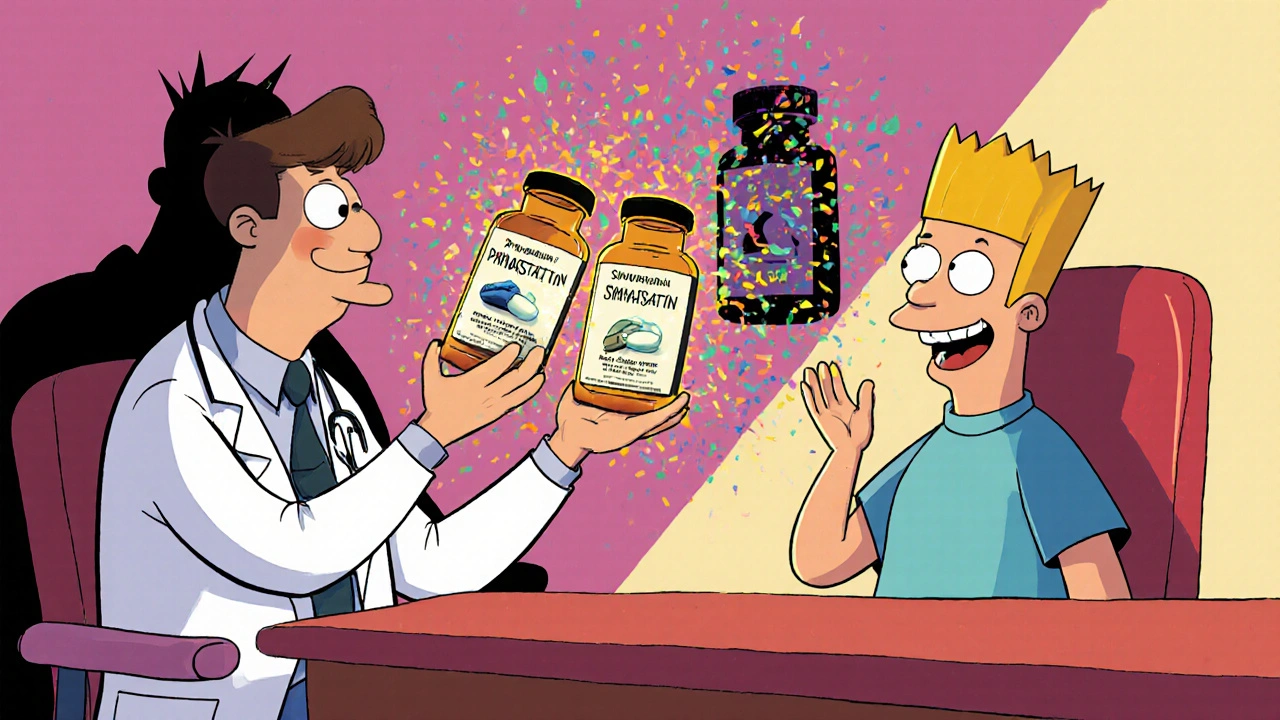
Alternatives That Are Safer
You don’t have to stay on simvastatin if the risks outweigh the benefits. There are statins that don’t rely on CYP3A4:- Pravastatin: Metabolized differently. Much lower interaction risk.
- Rosuvastatin: Strong cholesterol-lowering power, minimal CYP3A4 involvement.
- Pitavastatin: Newer, with very few drug interactions and good efficacy.
These alternatives may cost more, but they’re worth it if you’re on multiple medications or have a history of muscle issues. Talk to your doctor about switching. Many insurance plans cover them, especially now that generic versions are widely available.
Why This Matters Now
Simvastatin is cheap - under $4 a month for 20 mg. That’s why it’s still used. But cheap doesn’t mean safe. The 80 mg dose is now almost never prescribed for new patients. The FDA, American College of Cardiology, and American Heart Association all agree: avoid it unless absolutely necessary. And yet, patients are still dying from interactions that could have been caught. A 72-year-old man on simvastatin 40 mg started clarithromycin for pneumonia. Three days later, he was hospitalized with rhabdomyolysis. His CK level was 25,000 U/L (normal is under 200). He survived - but barely. These aren’t rare cases. In 2022, the FDA received 187 reports of rhabdomyolysis linked to simvastatin. Over 60% involved doses of 40 mg or higher.Bottom Line: Don’t Guess - Check
If you’re on simvastatin, don’t assume your meds are safe. Don’t rely on memory. Don’t trust that your doctor knows everything you’re taking. Sit down with your pharmacist. Make a list. Ask: “Could any of these be dangerous with simvastatin?” And if you’re on the 80 mg dose - seriously consider switching. The risk isn’t worth it. Safer, just-as-effective options exist. Your muscles - and your kidneys - will thank you.Can I take simvastatin with antibiotics?
Some antibiotics are safe, others are deadly. Avoid clarithromycin and erythromycin completely. Azithromycin is usually fine. Always check with your pharmacist before starting any new antibiotic while on simvastatin.
Is grapefruit juice really that dangerous with simvastatin?
Yes. A single glass can raise simvastatin levels by 260%. This isn’t a myth - it’s proven in clinical studies. Even occasional consumption increases risk. Avoid all grapefruit products - juice, fruit, and even some flavored sodas or candies.
What should I do if I start feeling muscle pain on simvastatin?
Stop taking simvastatin immediately and contact your doctor. Muscle pain, weakness, or dark urine could signal rhabdomyolysis - a medical emergency. Don’t wait to see if it gets better. Early treatment can prevent kidney damage or death.
Is simvastatin 80 mg still prescribed today?
It’s rarely prescribed for new patients. Since the FDA’s 2011 warning, new prescriptions for the 80 mg dose have dropped by over 80%. It’s now reserved for a tiny fraction of patients who haven’t responded to lower doses or other statins - and only with strict monitoring.
Are there safer statins than simvastatin?
Yes. Pravastatin, rosuvastatin, and pitavastatin have far fewer drug interactions. They’re just as effective at lowering cholesterol and carry a much lower risk of muscle damage when taken with other medications. Ask your doctor if switching is right for you.

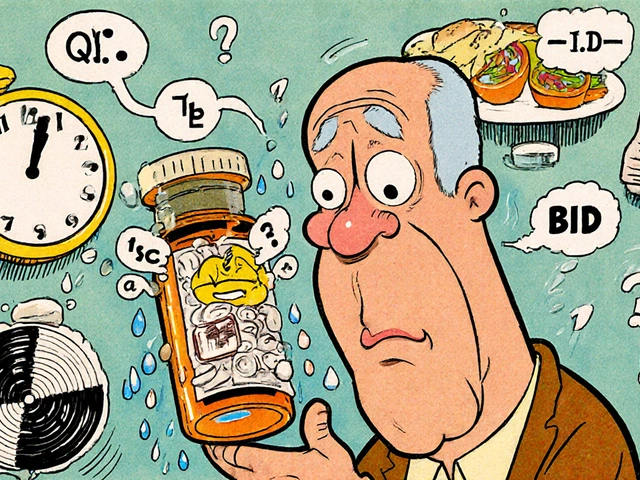
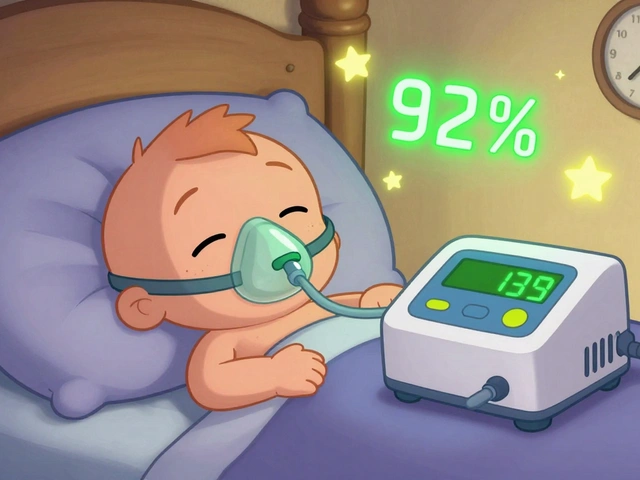

Eileen Choudhury
November 1, 2025Okay but can we talk about how wild it is that grapefruit juice is basically a silent killer here? I used to drink it every morning like it was water - now I’m sipping on orange juice like a paranoid robot. My pharmacist laughed when I asked about it, then got serious and said, ‘You’re lucky you’re not in the ICU.’
andrea navio quiros
November 1, 2025Simvastatin CYP3A4 inhibition is a classic pharmacokinetic nightmare and the FDA’s 2011 warning was long overdue but honestly most docs still don’t screen properly and patients are clueless because they think meds are safe if they’re generic and cheap this is systemic negligence wrapped in a $4 bottle
Pradeep Kumar
November 3, 2025Bro this hit different 😔 I’m on simva 40mg and just started clarithromycin last week for a sinus thing… I had no idea. I’m calling my doc tomorrow. Also grapefruit? I thought it was just a myth. Thanks for the wake-up call. Stay safe fam 🙏
Andy Ruff
November 3, 2025People need to stop being lazy about their health. You take a drug that’s been known to kill since the 90s and then you drink grapefruit juice like it’s a wellness trend? You think your ‘I’m just one glass a week’ excuse matters? It doesn’t. Your kidneys don’t care about your ‘moderation.’ This isn’t a suggestion - it’s a death sentence waiting to happen and if you’re still on 80mg you’re either a medical miracle or a walking autopsy.
Matthew Kwiecinski
November 4, 2025Pravastatin and rosuvastatin are not equally effective. Rosuvastatin has higher potency per mg but also higher risk of new-onset diabetes in predisposed individuals. Pitavastatin has better LDL reduction than pravastatin but lacks long-term outcome data in elderly populations. The FDA’s 2011 advisory specifically cited the SEARCH trial’s rhabdomyolysis incidence rate of 0.61% at 80mg vs 0.08% at 20-40mg - this is statistically significant at p<0.001. Genetic testing for SLCO1B1 is underutilized and should be standard before initiating simvastatin above 20mg.
Justin Vaughan
November 5, 2025Big shoutout to the pharmacist who saved my life. I was on 40mg simva + amiodarone for AFib - didn’t even know it was a combo that could fry my muscles. My pharmacist flagged it the second I walked in. Switched me to rosuvastatin 10mg. Zero muscle pain since. Don’t just trust your doctor - talk to the person who actually knows what’s in your meds. They’re the real MVPs.
Manuel Gonzalez
November 6, 2025Thanks for laying this out so clearly. I’ve been on simvastatin for 8 years and never realized how many things could interact with it. I just checked my meds - turns out I’ve been taking an OTC sleep aid with diphenhydramine and melatonin. No CYP3A4 blocker, but still, better safe than sorry. I’m scheduling a med review with my pharmacist this week.
Brittney Lopez
November 6, 2025My mom was on 80mg simva for years and never knew the risks. She got hospitalized last year after a short course of antifungals for a yeast infection. She’s fine now but it scared us all to death. If you’re on simvastatin, please, please, please get a full med review. Even if you think you’re fine - you might not be.
Jens Petersen
November 6, 2025Let’s be real - this isn’t about ‘dangerous combinations.’ It’s about pharmaceutical negligence disguised as cost-cutting. Simvastatin 80mg was never a good idea, but it was profitable. Pharma companies knew the risks. Doctors ignored the warnings. Patients were left to guess. And now we have a generation of people who think ‘generic’ means ‘safe.’ This is a systemic failure wrapped in a $4 pill bottle - and until we stop treating medicine like a commodity, people will keep dying because someone prioritized profit over prudence.